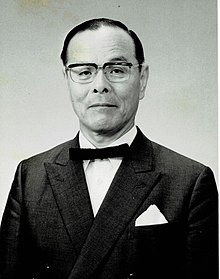Minoru Yamada
Minoru Yamada (in Japanese script: 仏 文学), (born February 10, 1930 in Kyōto ) is a Japanese civil engineer , earthquake researcher and university professor .
Life
The son of Masamitu and Yuki Yamada attended the Third State High School in Kyōto and took up engineering studies at the university there in 1949, which he completed in 1954 with a Bachelor of Science . He was followed by a Master of Science degree in 1956 , where his in-depth work in the field of structural engineering “Rotability of plastic joints in reinforced concrete beams” indicates his later field of work: research into ductile structures based on the theory of plasticity ; The quantification of the ductility of structures is of crucial importance for their dimensioning against earthquakes.
In 1957/1958 Yamada spent a year as a DAAD scholarship holder at the Institute for Statics and Steel Construction at the TH Darmstadt , headed by Kurt Klöppel . It was there that the pioneering three-part article about flow polyhedra of the rectangular and I-cross-section in the journal Der Stahlbau (now Stahlbau ) was published from 1958 to 1960 . The flow condition for anisotropic material formulated there is a fundamental contribution to the generalization of the ultimate load method and should be included in the specialist literature as the flow condition by Klöppel-Yamada .
Back in Japan, Yamada presented his dissertation contributions to the load bearing method at the University of Kyoto in 1959 . Until 1964 he worked as extraordinary professor and from April 1964 until his retirement in 1992 as professor at the University of Kobe . He then followed an appointment at Kansai University Osaka , which Yamada was loyal to until 2000. Nevertheless, he maintained intensive scientific contacts to steel construction science in Germany. This is not only demonstrated by his visiting professorships at the TU Braunschweig and TU Hamburg-Harburg and his profound publications in the journal Stahlbau, but also by the active support of Karl-Eugen Kurrer's book on the history of structural engineering .
Yamada's work on building in earthquake areas shaped his research life. Not only his discovery of the sudden shear fracture of compact reinforced concrete columns should be mentioned, but also his dual strategy in the field of earthquake safety, which pragmatically solves the conflict of goals between safety and economic efficiency: For the frequent weak earthquakes, Yamada suggests that the dimensioning should be designed so that the Any structural damage that occurs can be eliminated without high costs, whereas in the case of the rare strong earthquakes, a type of failure of the support system is selected that is possible without loss of human life. That is why Yamada criticizes the method of static equivalent load cases for earthquakes as being unrealistic and instead proposes his “resonance fatigue capacity method” developed with Hiroshi Kawamura - a method that understands the vibration fracture caused by earthquakes as a resonance state and combines the fracture behavior of the structure with vibration theory.
Honors
In 1969 Yamada received the Science Prize of the Japanese Institute of Architecture in 1969 for his work "Contribution to the investigation of elasto-plastic deformations and the fracture behavior of buildings". The University of Kobe made him an honorary professor. Eventually he became an honorary member of the Japanese Steel Construction Association, the Japanese Concrete Association and the Japanese Chamber of Architects.
Fonts
- Kurt Klöppel and Minoru Yamada: Flow polyhedra of rectangular and I cross-sections under the effect of bending moment, normal force and shear force . A contribution to the general load-bearing method for flat frames, in: Stahlbau , 27th year (1958), no. 11, pp. 284–290, 28th year (1959), p. 112 and 29th year (1960) , Pp. 173-179.
- Minoru Yamada: Earthquake Safety of Buildings, Part I: Basic Ideas , in: Stahlbau, 49th year (1980), no. 8, pp. 225-231 and no. 9, pp. 276-281.
- Minoru Yamada and Hiroshi Kawamura: Earthquake Safety of Buildings, Part II: Steel Buildings, Steel Frame Structures, in: Stahlbau, 49th year (1980), no. 10, pp. 302-311.
- Minoru Yamada, T. Kawabata and K. Yamanaka: Flexural fatigue failure of steel columns with I and box cross sections. Part I: Experiments , in: Stahlbau, 58th Jg. (1989), H. 12, pp. 361-364.
- Minoru Yamada and Y. Hashimoto: Fatigue fracture of sheet metal strips under alternately repeated tension and pressure , in: Stahlbau, 59th Jg. (1990), H. 7, pp. 213-217.
- Minoru Yamada: * Recent findings on the stress and resistance of steel structures during earthquakes *, in: Stahlbau, 70th Jg. (2001), no. 9, pp. 698–709.
- Minoru Yamada: Thrust problems in structural engineering , in: Bautechnik , 82nd year (2005), no. 1, pp. 33–41.
- Minoru Yamada and H. Masuda: Elasto-plastic shear deformations and shear failure of short steel columns , in: Stahlbau, 75th year (2006), no. 12, pp. 983-992.
swell
- Richard Schardt : Minoru Yamada 80 years , in: Stahlbau, 79th year (2010), no. 4, pp. 323-324.
| personal data | |
|---|---|
| SURNAME | Yamada, Minoru |
| BRIEF DESCRIPTION | Japanese civil engineer, earthquake researcher and university professor |
| DATE OF BIRTH | February 10, 1930 |
| PLACE OF BIRTH | Kyoto |
